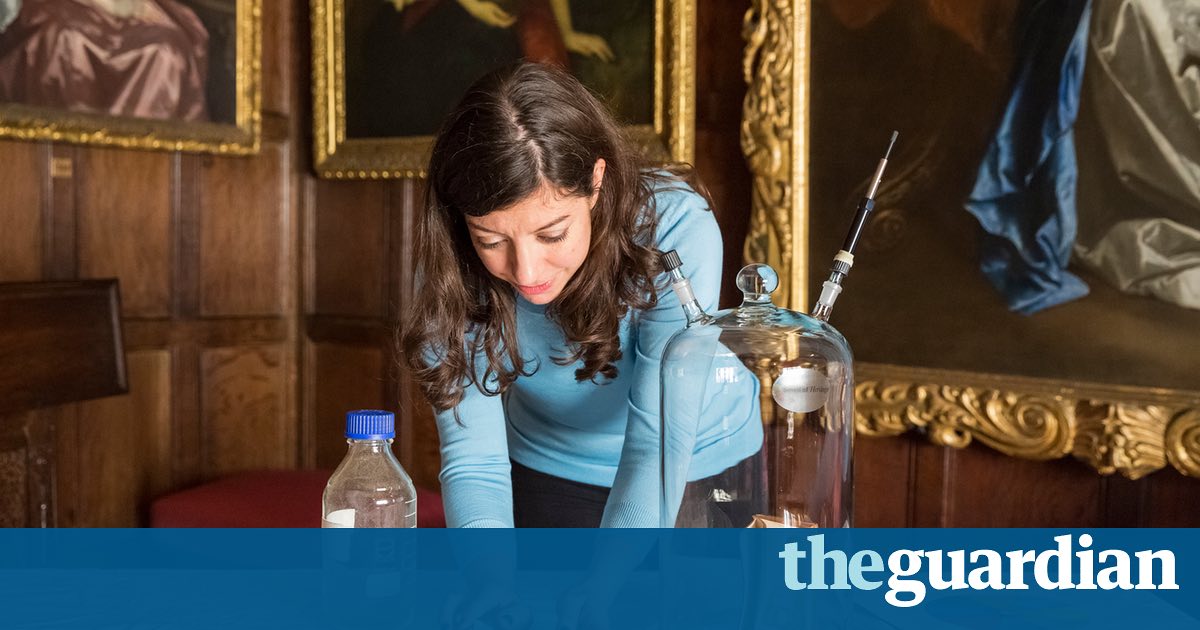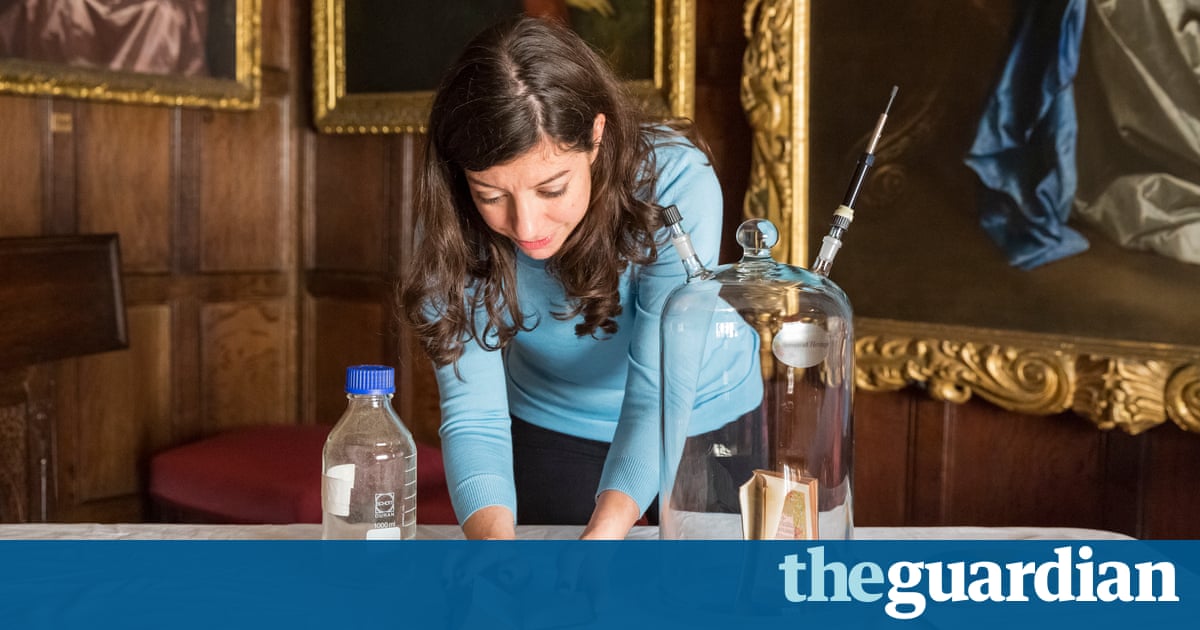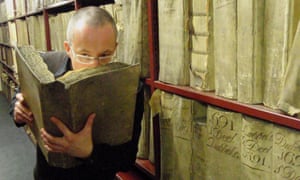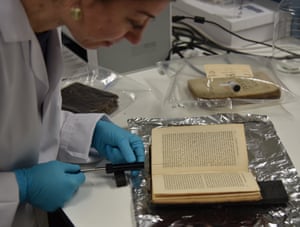Can you judge a book by its odour?

Cocoa, wood, rusks every book has a distinctive smell. And each smell says something about how and when it was made, and where it has been.

What does it mean to experience a book? To a bibliophile such as Alberto Manguel, smell plays an important part. In a talk at the British Library this week, the one-time protege of Jorge Luis Borges and director of the National Library of Argentina said he was particularly partial to old Penguin paperbacks, which he loved for their odour of fresh rusk biscuits.
Audience members responded with their own sense impressions. Peter, a pensioner, said he experienced books as smelling of salt and pepper that dryness when you open the cupboard with a touch of the sea, while 46-year-old Donna confessed that she had recently bought a book for her young son partly because it smelled of the rain.
To conservators and historians, smell has always played an important role in assessing the origin and condition of historic books, and in working out how to look after them. I have no vocabulary to define this, but there is a curious warm leathery smell to English parchment, unlike the sharper, cooler scent of Italian skins, wrote the Cambridge University don and librarian Christopher de Hamel in his bestselling Meetings with Remarkable Manuscripts.
But that lack of vocabulary could be about to change, thanks to a groundbreaking project by researchers at UCL Institute for Sustainable Heritage, who have devised a way of relating such apparently subjective descriptions directly to the chemical composition of books. In a paper published this week in the journal Heritage Science, Cecilia Bembibre and Matija Strli describe how they analysed samples from an old book, picked up in a second-hand shop, and developed a historic book odour wheel, which connects identifiable chemicals with peoples reactions to them.
Using fibres from the novel, they produced an extract of historic book, which was presented to 79 visitors to Birmingham Museum and Art Gallery. Chocolate, cocoa or chocolatey were the most frequent words used to describe the smell of a copy of French writer Bernard Gassets 1928 novel Les Chardons du Baragan, followed by coffee, old, wood and burnt.
From the analytical perspective, and given that coffee and chocolate come from fermented/roasted natural lignin and cellulose-containing product, they share many VOCs (volatile organic compounds) with decaying paper, wrote the researchers, who combined the results with those of earlier research projects, such as studies of a 1940s visitors book at the National Trusts Knole House in Kent. Their study also took them beyond books themselves, to the places in which many of them are read: libraries. In another experiment, they asked visitors to the Wren Library in St Pauls cathedral to describe what the library smelled like to them. Everyone described its smell as woody, while 86% also experienced it as smoky, 71% as earthy and just under half (41%) reported the scent of vanilla all smells associated with particular chemicals in old books.

The project originated in Strlis observation of the importance of smell to conservators and librarians. Librarians have told us that its the smell that hits readers first. Its the way libraries communicate, before people even get to the books; but what the books communicate through smell is also interesting. The idea is to propose a large theoretical framework of which smells hold cultural value for us as a society, he says.
Strli, a professor of heritage science at UCL, is a chemist by training. We know very well how to analyse the chemicals, but what they mean, and the emotions they trigger, is a completely different matter. For that, you need a multi-disciplinary study, he says. It wasnt until the arrival of Bembibre a PhD student with a background in communications that the project began to acquire an anthropological and cultural breadth.
“Libraries such as St Paul’s, dedicated to historic books, smell different to those housing more recent literature,” says Strli. “We know that books produced before approximately 1850 have a different smell to those produced between 1850 and 1990, and that’s because late 19th- and most 20th-century printing was dominated by acid sizing the process to which pulp was subjected to reduce the water-absorbancy of paper, so that it could then be written on.”
The life of individual books also affects their smell: how far they have travelled; whether they have been kept in damp or dry environments. As De Hamel points out, some manuscripts have hardly stirred from their original shelves since the day they were completed; others have zig-zagged across the known world in wooden chests or saddle bags, swaying on the backs of horses or over the oceans in little sailing ships, or as aircraft freight.
The medieval manuscripts De Hamel was dealing with were created by hand on long-lasting parchment made from animal skins which also have their own distinctive smell. Industrialised publishing from the mid 19th-century created less-hardy books, prone to a fate that every secondhand book collector fears: foxing, the brown blotches that appear on so many old volumes. Foxing happens when small impurities left by the metal beaters used to process the paper pulp combine with fungal growth on the ageing paper.
Many people assume the blotches themselves give old books their familiar musty pong. “In fact,” says Strli, “the smell is due to the release of chemicals such as furfural and hexanol as the paper itself decays.” Hexanol is often described as smelling farmlike or of old clothing or old room, which the odour wheel consigns to a category labelled earthy/musty/mouldy.

But foxing itself is likely to be less prevalent as manufacturing changes. In the 1980’s, the technology changed because of environmental concerns about the chlorinated chemicals emitted through the manufacture process. The happy consequence of that was that the paper became more stable again, says Strli.
The researchers believe the historic book odour wheel could become a useful diagnostic tool for conservators across a wide range of areas, helping them to assess the condition of objects through their olfactory profile. If a book smells chocolatey, its likely that it is releasing vanillin, benzaldehyde and furfural three chemicals associated with the degradation of the cellulose and lignin in paper. But the study also has wider implications, as the heritage industry grapples with a new interest in the historical importance of smell. By documenting the words used to describe a heritage smell, our study opens a discussion about developing a vocabulary to identify aromas that have cultural meaning and significance, says Bembibre.
So what can the odour wheel tell us about Manguels description of Penguin books as smelling like fresh rusk biscuits? Biscuits is a word that often comes up when describing books. Two compounds in particular: furfural (smelling of sweetness or bread) and vanillin (smelling of vanilla) could be responsible, says Bembibre. His words might indicate that the books themselves are deteriorating, but they also reveal his pleasure in them. The gift industry has long wised up to this. The British Library shop, a few metres from the theatre where Manguel was speaking, sells a candle that purports to smell of library.
“This is not just about the composition of smell itself, but about human sensibility,” Bembibre says. “By reconstructing the smell and assessing the human reaction to it, we will be able to work out what it is that we want to preserve.”
Read more: https://www.theguardian.com/books/2017/apr/07/the-smell-of-old-books-science-libraries